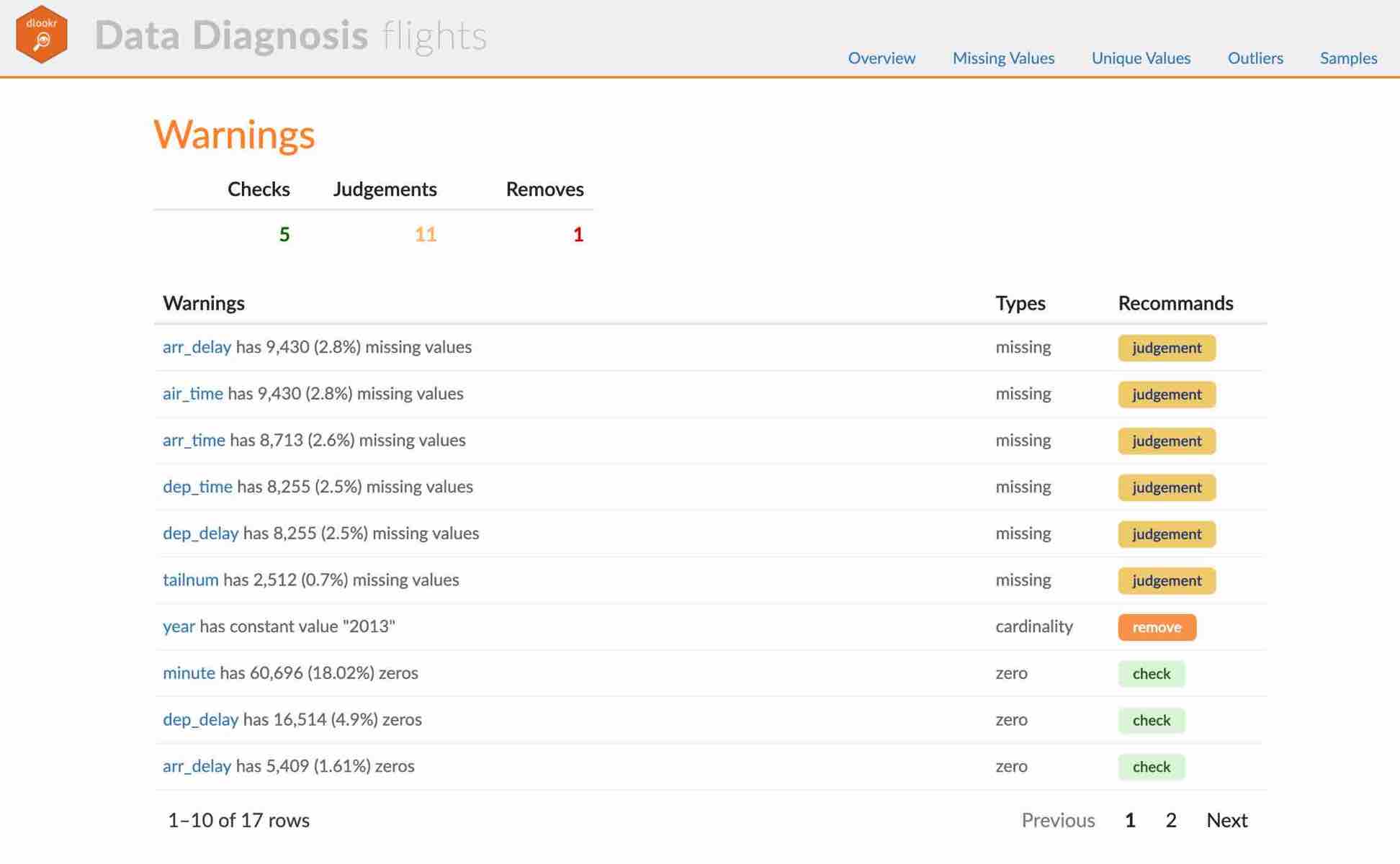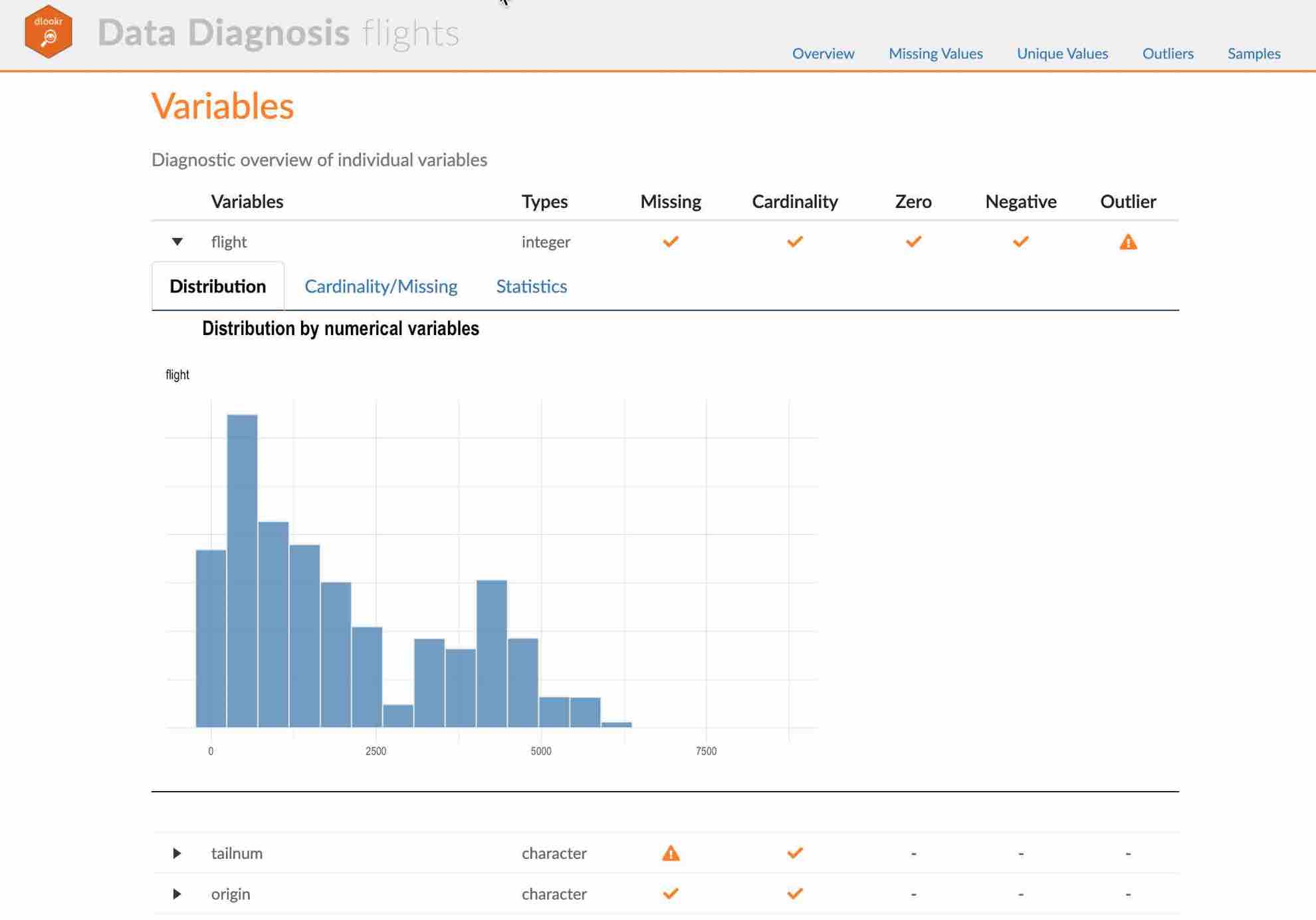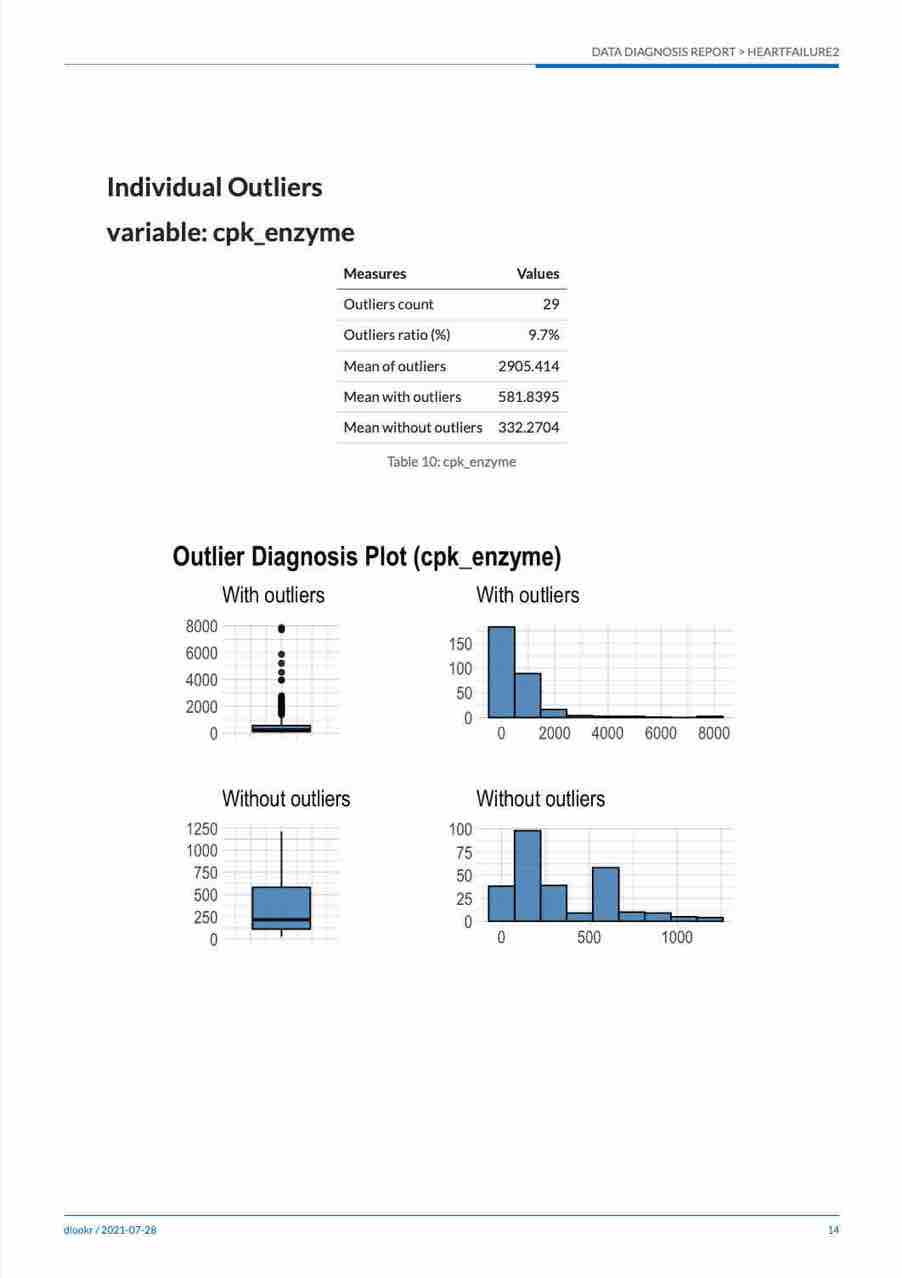Preface
After you have acquired the data, you should do the following:
-
Diagnose data quality.
- If there is a problem with data quality,
- The data must be corrected or re-acquired.
- Explore data to understand the data and find scenarios for performing the analysis.
- Derive new variables or perform variable transformations.
The dlookr package makes these steps fast and easy:
- Performs a data diagnosis or automatically generates a data diagnosis report.
- Discover data in various ways and automatically generate EDA(exploratory data analysis) reports.
- Impute missing values and outliers, resolve skewed data, and categorize continuous variables into categorical variables. And generates an automated report to support it.
This document introduces Data Quality Diagnosis
methods provided by the dlookr package. You will learn how to diagnose
the quality of tbl_df data that inherits from data.frame
and data.frame with functions provided by dlookr.
dlookr increases synergy with dplyr. Particularly in
data exploration and data wrangling, it increases the efficiency of the
tidyverse package group.
Supported data structures
Data diagnosis supports the following data structures.
- data frame: data.frame class.
- data table: tbl_df class.
-
table of DBMS: table of the DBMS through tbl_dbi.
- Use dplyr as the back-end interface for any DBI-compatible database.
Data: nycflights13
To illustrate the primary use of the dlookr package, use the
flights data from the nycflights13 package.
The flights data frame is data about departure and arrival
on all flights departing from NYC in 2013.
dim(flights)
[1] 3000 19
flights
[38;5;246m# A tibble: 3,000 × 19
[39m
year month day dep_time sched_dep_time dep_delay arr_time sched_arr_time
[3m
[38;5;246m<int>
[39m
[23m
[3m
[38;5;246m<int>
[39m
[23m
[3m
[38;5;246m<int>
[39m
[23m
[3m
[38;5;246m<int>
[39m
[23m
[3m
[38;5;246m<int>
[39m
[23m
[3m
[38;5;246m<dbl>
[39m
[23m
[3m
[38;5;246m<int>
[39m
[23m
[3m
[38;5;246m<int>
[39m
[23m
[38;5;250m1
[39m
[4m2
[24m013 6 17
[4m1
[24m033
[4m1
[24m040 -
[31m7
[39m
[4m1
[24m246
[4m1
[24m309
[38;5;250m2
[39m
[4m2
[24m013 12 26
[4m1
[24m343
[4m1
[24m329 14
[4m1
[24m658
[4m1
[24m624
[38;5;250m3
[39m
[4m2
[24m013 8 26
[4m1
[24m258
[4m1
[24m218 40
[4m1
[24m510
[4m1
[24m516
[38;5;250m4
[39m
[4m2
[24m013 8 17
[4m1
[24m558
[4m1
[24m600 -
[31m2
[39m
[4m1
[24m835
[4m1
[24m849
[38;5;246m# ℹ 2,996 more rows
[39m
[38;5;246m# ℹ 11 more variables: arr_delay <dbl>, carrier <chr>, flight <int>,
[39m
[38;5;246m# tailnum <chr>, origin <chr>, dest <chr>, air_time <dbl>, distance <dbl>,
[39m
[38;5;246m# hour <dbl>, minute <dbl>, time_hour <dttm>
[39mData diagnosis
dlookr aims to diagnose the data and select variables that can not be used for data analysis or to find the variables that need calibration.:
-
diagnose()provides basic diagnostic information for variables. -
diagnose_category()provides detailed diagnostic information for categorical variables. -
diagnose_numeric()provides detailed diagnostic information for numerical variables. -
diagnose_outlier()andplot_outlier()provide information and visualization of outliers.
General diagnosis of all variables with diagnose()
diagnose() allows the diagnosis of variables in a data
frame. Like the function of dplyr, the first argument is the tibble (or
data frame). The second and subsequent arguments refer to variables
within that data frame.
The variables of the tbl_df object returned by
diagnose () are as follows.
-
variables: variable names -
types: the data type of the variables -
missing_count: number of missing values -
missing_percent: percentage of missing value -
unique_count: number of unique value -
unique_rate: rate of unique value. unique_count / number of observation
For example, we can diagnose all variables in
flights:
diagnose(flights)
[38;5;246m# A tibble: 19 × 6
[39m
variables types missing_count missing_percent unique_count unique_rate
[3m
[38;5;246m<chr>
[39m
[23m
[3m
[38;5;246m<chr>
[39m
[23m
[3m
[38;5;246m<int>
[39m
[23m
[3m
[38;5;246m<dbl>
[39m
[23m
[3m
[38;5;246m<int>
[39m
[23m
[3m
[38;5;246m<dbl>
[39m
[23m
[38;5;250m1
[39m year integer 0 0 1 0.000
[4m3
[24m
[4m3
[24m
[4m3
[24m
[38;5;250m2
[39m month integer 0 0 12 0.004
[38;5;250m3
[39m day integer 0 0 31 0.010
[4m3
[24m
[38;5;250m4
[39m dep_time integer 82 2.73 982 0.327
[38;5;246m# ℹ 15 more rows
[39m-
Missing Value(NA): Variables with many missing values, i.e., those with amissing_percentclose to 100, should be excluded from the analysis. -
Unique value: If the data type is not numeric (integer, numeric) and the number of unique values equals the number of observations (unique_rate = 1), the variable will likely be an identifier. Therefore, this variable is also not suitable for the analysis mode
year can be considered not to be used in the analysis
model since unique_count is 1. However, you do not have to
remove it if you configure date as a combination of
year, month, and day.
For example, we can diagnose only a few selected variables:
# Select columns by name
diagnose(flights, year, month, day)
[38;5;246m# A tibble: 3 × 6
[39m
variables types missing_count missing_percent unique_count unique_rate
[3m
[38;5;246m<chr>
[39m
[23m
[3m
[38;5;246m<chr>
[39m
[23m
[3m
[38;5;246m<int>
[39m
[23m
[3m
[38;5;246m<dbl>
[39m
[23m
[3m
[38;5;246m<int>
[39m
[23m
[3m
[38;5;246m<dbl>
[39m
[23m
[38;5;250m1
[39m year integer 0 0 1 0.000
[4m3
[24m
[4m3
[24m
[4m3
[24m
[38;5;250m2
[39m month integer 0 0 12 0.004
[38;5;250m3
[39m day integer 0 0 31 0.010
[4m3
[24m
# Select all columns between year and day (include)
diagnose(flights, year:day)
[38;5;246m# A tibble: 3 × 6
[39m
variables types missing_count missing_percent unique_count unique_rate
[3m
[38;5;246m<chr>
[39m
[23m
[3m
[38;5;246m<chr>
[39m
[23m
[3m
[38;5;246m<int>
[39m
[23m
[3m
[38;5;246m<dbl>
[39m
[23m
[3m
[38;5;246m<int>
[39m
[23m
[3m
[38;5;246m<dbl>
[39m
[23m
[38;5;250m1
[39m year integer 0 0 1 0.000
[4m3
[24m
[4m3
[24m
[4m3
[24m
[38;5;250m2
[39m month integer 0 0 12 0.004
[38;5;250m3
[39m day integer 0 0 31 0.010
[4m3
[24m
# Select all columns except those from year to day (exclude)
diagnose(flights, -(year:day))
[38;5;246m# A tibble: 16 × 6
[39m
variables types missing_count missing_percent unique_count unique_rate
[3m
[38;5;246m<chr>
[39m
[23m
[3m
[38;5;246m<chr>
[39m
[23m
[3m
[38;5;246m<int>
[39m
[23m
[3m
[38;5;246m<dbl>
[39m
[23m
[3m
[38;5;246m<int>
[39m
[23m
[3m
[38;5;246m<dbl>
[39m
[23m
[38;5;250m1
[39m dep_time integer 82 2.73 982 0.327
[38;5;250m2
[39m sched_dep_time integer 0 0 588 0.196
[38;5;250m3
[39m dep_delay numeric 82 2.73 204 0.068
[38;5;250m4
[39m arr_time integer 87 2.9
[4m1
[24m010 0.337
[38;5;246m# ℹ 12 more rows
[39mUsing dplyr, variables, including missing values, can be sorted by the weight of missing values.:
flights %>%
diagnose() %>%
select(-unique_count, -unique_rate) %>%
filter(missing_count > 0) %>%
arrange(desc(missing_count))
[38;5;246m# A tibble: 6 × 4
[39m
variables types missing_count missing_percent
[3m
[38;5;246m<chr>
[39m
[23m
[3m
[38;5;246m<chr>
[39m
[23m
[3m
[38;5;246m<int>
[39m
[23m
[3m
[38;5;246m<dbl>
[39m
[23m
[38;5;250m1
[39m arr_delay numeric 89 2.97
[38;5;250m2
[39m air_time numeric 89 2.97
[38;5;250m3
[39m arr_time integer 87 2.9
[38;5;250m4
[39m dep_time integer 82 2.73
[38;5;246m# ℹ 2 more rows
[39mDiagnosis of numeric variables with
diagnose_numeric()
diagnose_numeric() diagnoses numeric(continuous and
discrete) variables in a data frame. Usage is the same as
diagnose() but returns more diagnostic information.
However, if you specify a non-numeric variable in the second and
subsequent argument list, the variable is automatically ignored.
The variables of the tbl_df object returned by
diagnose_numeric() are as follows.
-
min: minimum value -
Q1: 1/4 quartile, 25th percentile -
mean: arithmetic mean -
median: median, 50th percentile -
Q3: 3/4 quartile, 75th percentile -
max: maximum value -
zero: number of observations with a value of 0 -
minus: number of observations with negative numbers -
outlier: number of outliers
The summary() function summarizes the distribution of individual
variables in the data frame and outputs it to the console. The summary
values of numeric variables are min, Q1,
mean, median, Q3 and
max, which help to understand the data distribution.
However, the result displayed on the console has the disadvantage
that the analyst has to look at it with the eyes. However, when the
summary information is returned in a data frame structure such as
tbl_df, the scope of utilization is expanded.
diagnose_numeric() supports this.
zero, minus, and outlier are
helpful measures to diagnose data integrity. For example, in some cases,
numerical data cannot have zero or negative numbers. A numeric variable,
employee salary, cannot have negative numbers or zeros.
Therefore, this variable should be checked for the inclusion of zero or
negative numbers in the data diagnosis process.
diagnose_numeric() can diagnose all numeric variables of
flights as follows.:
diagnose_numeric(flights)
[38;5;246m# A tibble: 14 × 10
[39m
variables min Q1 mean median Q3 max zero minus outlier
[3m
[38;5;246m<chr>
[39m
[23m
[3m
[38;5;246m<dbl>
[39m
[23m
[3m
[38;5;246m<dbl>
[39m
[23m
[3m
[38;5;246m<dbl>
[39m
[23m
[3m
[38;5;246m<dbl>
[39m
[23m
[3m
[38;5;246m<dbl>
[39m
[23m
[3m
[38;5;246m<dbl>
[39m
[23m
[3m
[38;5;246m<int>
[39m
[23m
[3m
[38;5;246m<int>
[39m
[23m
[3m
[38;5;246m<int>
[39m
[23m
[38;5;250m1
[39m year
[4m2
[24m013
[4m2
[24m013
[4m2
[24m013
[4m2
[24m013
[4m2
[24m013
[4m2
[24m013 0 0 0
[38;5;250m2
[39m month 1 4 6.54 7 9.25 12 0 0 0
[38;5;250m3
[39m day 1 8 15.8 16 23 31 0 0 0
[38;5;250m4
[39m dep_time 1 905.
[4m1
[24m354.
[4m1
[24m417
[4m1
[24m755
[4m2
[24m359 0 0 0
[38;5;246m# ℹ 10 more rows
[39mIf a numeric variable can not logically have a negative or zero
value, it can be used with filter() to easily find a
variable that does not logically match:
diagnose_numeric(flights) %>%
filter(minus > 0 | zero > 0)
[38;5;246m# A tibble: 3 × 10
[39m
variables min Q1 mean median Q3 max zero minus outlier
[3m
[38;5;246m<chr>
[39m
[23m
[3m
[38;5;246m<dbl>
[39m
[23m
[3m
[38;5;246m<dbl>
[39m
[23m
[3m
[38;5;246m<dbl>
[39m
[23m
[3m
[38;5;246m<dbl>
[39m
[23m
[3m
[38;5;246m<dbl>
[39m
[23m
[3m
[38;5;246m<dbl>
[39m
[23m
[3m
[38;5;246m<int>
[39m
[23m
[3m
[38;5;246m<int>
[39m
[23m
[3m
[38;5;246m<int>
[39m
[23m
[38;5;250m1
[39m dep_delay -
[31m22
[39m -
[31m5
[39m 13.6 -
[31m1
[39m 12
[4m1
[24m126 143
[4m1
[24m618 401
[38;5;250m2
[39m arr_delay -
[31m70
[39m -
[31m17
[39m 7.13 -
[31m5
[39m 15
[4m1
[24m109 43
[4m1
[24m686 250
[38;5;250m3
[39m minute 0 9.75 26.4 29 44 59 527 0 0Diagnosis of categorical variables with
diagnose_category()
diagnose_category() diagnoses the categorical(factor,
ordered, character) variables of a data frame. The usage is similar to
diagnose() but returns more diagnostic information. The
variable is automatically ignored if you specify a non-categorical
variable in the second and subsequent argument list.
The top argument specifies the number of levels to
return for each variable. The default is 10, which returns the top 10
levels. Of course, if the number of levels is less than 10, all levels
are returned.
The variables of the tbl_df object returned by
diagnose_category() are as follows.
-
variables: variable names -
levels: level names -
N: number of observation -
freq: number of observation at the levels -
ratio: percentage of observation at the levels -
rank: rank of occupancy ratio of levels
`diagnose_category() can diagnose all categorical
variables of flights as follows.:
diagnose_category(flights)
[38;5;246m# A tibble: 43 × 6
[39m
variables levels N freq ratio rank
[3m
[38;5;246m<chr>
[39m
[23m
[3m
[38;5;246m<chr>
[39m
[23m
[3m
[38;5;246m<int>
[39m
[23m
[3m
[38;5;246m<int>
[39m
[23m
[3m
[38;5;246m<dbl>
[39m
[23m
[3m
[38;5;246m<int>
[39m
[23m
[38;5;250m1
[39m carrier UA
[4m3
[24m000 551 18.4 1
[38;5;250m2
[39m carrier EV
[4m3
[24m000 493 16.4 2
[38;5;250m3
[39m carrier B6
[4m3
[24m000 490 16.3 3
[38;5;250m4
[39m carrier DL
[4m3
[24m000 423 14.1 4
[38;5;246m# ℹ 39 more rows
[39mIn collaboration with filter() in the dplyr
package, we can see that the tailnum variable is ranked in
top 1 with 2,512 missing values in the case where the missing value is
included in the top 10:
diagnose_category(flights) %>%
filter(is.na(levels))
[38;5;246m# A tibble: 1 × 6
[39m
variables levels N freq ratio rank
[3m
[38;5;246m<chr>
[39m
[23m
[3m
[38;5;246m<chr>
[39m
[23m
[3m
[38;5;246m<int>
[39m
[23m
[3m
[38;5;246m<int>
[39m
[23m
[3m
[38;5;246m<dbl>
[39m
[23m
[3m
[38;5;246m<int>
[39m
[23m
[38;5;250m1
[39m tailnum
[31mNA
[39m
[4m3
[24m000 23 0.767 1The following example returns a list where the level’s relative
percentage is 0.01% or less. Note that the value of the top
argument is set to a large value, such as 500. If the default value of
10 were used, values below 0.01% would not be included in the list:
flights %>%
diagnose_category(top = 500) %>%
filter(ratio <= 0.01)
[38;5;246m# A tibble: 0 × 6
[39m
[38;5;246m# ℹ 6 variables: variables <chr>, levels <chr>, N <int>, freq <int>,
[39m
[38;5;246m# ratio <dbl>, rank <int>
[39mIn the analytics model, you can also consider removing levels where the relative frequency is minimal in the observations or, if possible, combining them together.
Diagnosing outliers with diagnose_outlier()
diagnose_outlier() diagnoses the outliers of the data
frame’s numeric (continuous and discrete) variables. The usage is the
same as diagnose().
The variables of the tbl_df object returned by
diagnose_outlier() are as follows.
-
outliers_cnt: number of outliers -
outliers_ratio: percent of outliers -
outliers_mean: arithmetic average of outliers -
with_mean: arithmetic average of with outliers -
without_mean: arithmetic average of without outliers
diagnose_outlier() can diagnose outliers of all
numerical variables on flights as follows:
diagnose_outlier(flights)
[38;5;246m# A tibble: 14 × 6
[39m
variables outliers_cnt outliers_ratio outliers_mean with_mean without_mean
[3m
[38;5;246m<chr>
[39m
[23m
[3m
[38;5;246m<int>
[39m
[23m
[3m
[38;5;246m<dbl>
[39m
[23m
[3m
[38;5;246m<dbl>
[39m
[23m
[3m
[38;5;246m<dbl>
[39m
[23m
[3m
[38;5;246m<dbl>
[39m
[23m
[38;5;250m1
[39m year 0 0
[31mNaN
[39m
[4m2
[24m013
[4m2
[24m013
[38;5;250m2
[39m month 0 0
[31mNaN
[39m 6.54 6.54
[38;5;250m3
[39m day 0 0
[31mNaN
[39m 15.8 15.8
[38;5;250m4
[39m dep_time 0 0
[31mNaN
[39m
[4m1
[24m354.
[4m1
[24m354.
[38;5;246m# ℹ 10 more rows
[39mNumeric variables that contained outliers are easily found with
filter().:
diagnose_outlier(flights) %>%
filter(outliers_cnt > 0)
[38;5;246m# A tibble: 4 × 6
[39m
variables outliers_cnt outliers_ratio outliers_mean with_mean without_mean
[3m
[38;5;246m<chr>
[39m
[23m
[3m
[38;5;246m<int>
[39m
[23m
[3m
[38;5;246m<dbl>
[39m
[23m
[3m
[38;5;246m<dbl>
[39m
[23m
[3m
[38;5;246m<dbl>
[39m
[23m
[3m
[38;5;246m<dbl>
[39m
[23m
[38;5;250m1
[39m dep_delay 401 13.4 94.4 13.6 0.722
[38;5;250m2
[39m arr_delay 250 8.33 121. 7.13 -
[31m3
[39m
[31m.
[39m
[31m52
[39m
[38;5;250m3
[39m air_time 38 1.27 389. 149. 146.
[38;5;250m4
[39m distance 3 0.1
[4m4
[24m970.
[4m1
[24m029.
[4m1
[24m025. The following example finds a numeric variable with an outlier ratio of 5% or more and then returns the result of dividing the mean of outliers by the overall mean in descending order:
diagnose_outlier(flights) %>%
filter(outliers_ratio > 5) %>%
mutate(rate = outliers_mean / with_mean) %>%
arrange(desc(rate)) %>%
select(-outliers_cnt)
[38;5;246m# A tibble: 2 × 6
[39m
variables outliers_ratio outliers_mean with_mean without_mean rate
[3m
[38;5;246m<chr>
[39m
[23m
[3m
[38;5;246m<dbl>
[39m
[23m
[3m
[38;5;246m<dbl>
[39m
[23m
[3m
[38;5;246m<dbl>
[39m
[23m
[3m
[38;5;246m<dbl>
[39m
[23m
[3m
[38;5;246m<dbl>
[39m
[23m
[38;5;250m1
[39m arr_delay 8.33 121. 7.13 -
[31m3
[39m
[31m.
[39m
[31m52
[39m 16.9
[38;5;250m2
[39m dep_delay 13.4 94.4 13.6 0.722 6.94In cases where the mean of the outliers is large relative to the overall average, it may be desirable to impute or remove the outliers.
Visualization of outliers using plot_outlier()
plot_outlier() visualizes outliers of numerical
variables(continuous and discrete) of data.frame. Usage is the same as
diagnose().
The plot derived from the numerical data diagnosis is as follows.
- With outliers box plot
- Without outliers box plot
- With outliers histogram
- Without outliers histogram
plot_outlier() can visualize an outliers in the
arr_delay variable of flights as follows:
flights %>%
plot_outlier(arr_delay) 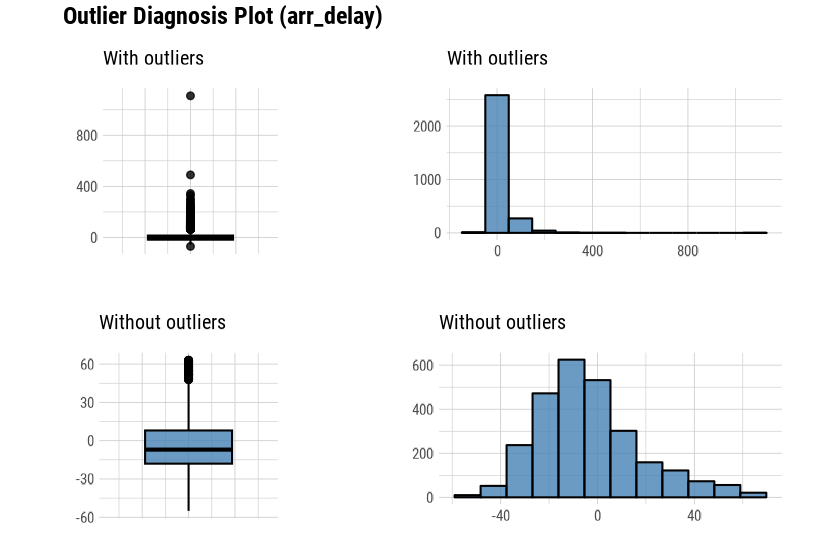
The following example uses diagnose_outlier(),
plot_outlier(), and dplyr packages to
visualize all numerical variables with an outlier ratio of 5% or
higher.
flights %>%
plot_outlier(diagnose_outlier(flights) %>%
filter(outliers_ratio >= 5) %>%
select(variables) %>%
unlist())Analysts should look at the visualization results to decide whether to remove or replace outliers. Sometimes, you should consider removing variables with outliers from the data analysis model.
Looking at the visualization results, arr_delay shows
that the observed values without outliers are similar to the normal
distribution. In the case of a linear model, we might consider removing
or imputing outliers.
Visualization for missing values
It is essential to look at the missing values of individual variables, but it is also important to look at the relationship between the variables, including the missing values.
dlookr provides a visualization tool that looks at the relationship of variables, including missing values.
visualize pareto chart using plot_na_pareto()
plot_na_pareto() draws a Pareto chart by collecting
variables, including missing values.
mice::boys %>%
plot_na_pareto(col = "blue")
The default value of the only_na argument is FALSE,
which includes variables that do not contain missing values. Still, only
variables containing missing values are visualized if this value is set
to TRUE. The variable age was excluded from this plot.
mice::boys %>%
plot_na_pareto(only_na = TRUE, main = "Pareto Chart for mice::boys")The rating of the variable is expressed as a proportion of missing
values. It is calculated as the ratio of missing values. If it is [0,
0.05), it is Good, if it is [0.05, 0.4) it is
OK, if it is [0.4, 0.8) it is Bad, and if it
is [0.8, 1.0] it is Remove. You can override this grade
using the grade argument as follows:
mice::boys %>%
plot_na_pareto(grade = list(High = 0.1, Middle = 0.6, Low = 1), relative = TRUE)If the plot argument is set to FALSE, information about
missing values is returned instead of plotting.
plot_na_pareto(mice::boys, only_na = TRUE, plot = FALSE)visualize combination chart using plot_na_hclust()
It is essential to look at the relationship between variables,
including missing values. plot_na_hclust() visualizes the
relationship of variables that contain missing values. This function
rearranges the positions of variables using hierarchical clustering.
Then, the expression of the missing value is visualized by grouping
similar variables.
mice::boys %>%
plot_na_hclust(main = "Distribution of missing value")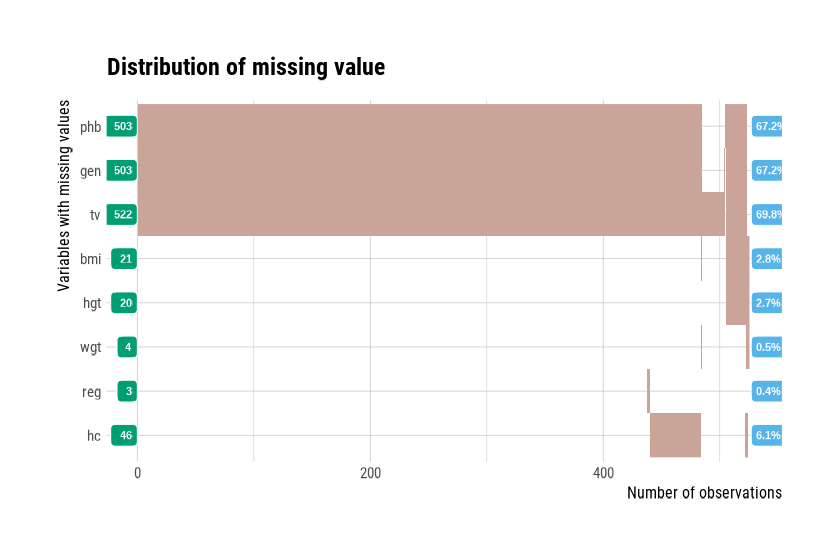
visualize combination chart using
plot_na_intersect()
plot_na_intersect() visualizes the combinations of
missing values across cases.
The visualization consists of four parts. The bottom left, which is the most basic, visualizes the case of cross(intersection)-combination. The x-axis is the variable including the missing value, and the y-axis represents the case of a combination of variables. And on the marginal of the two axes, the frequency of the case is expressed as a bar graph. Finally, the visualization at the top right expresses the number of variables, including missing values in the data set, and the number of observations, including missing values and complete cases.
This example visualizes the combination of variables that include missing values.
mice::boys %>%
plot_na_intersect()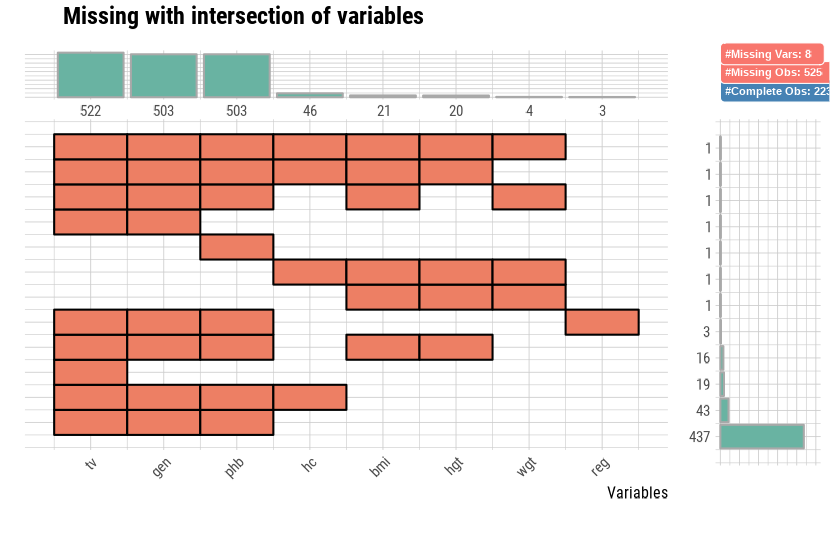
If the n_vars argument is used, only the top
n variables containing many missing values are
visualized.
mice::boys %>%
plot_na_intersect(n_vars = 5)If you use the n_intersacts argument, only the top n
numbers of variable combinations(intersection), including missing
values, are visualized. Suppose you want to visualize the combination
variables, that includes missing values and complete cases. You just add
only_na = FALSE.
mice::boys %>%
plot_na_intersect(only_na = FALSE, n_intersacts = 7)Automated report
dlookr provides two automated data diagnostic reports:
- Web page-based dynamic reports can perform in-depth analysis through visualization and statistical tables.
- Static reports generated as pdf files or html files can be archived as output of data analysis.
Create a diagnostic report using
diagnose_web_report()
diagnose_web_report() creates a dynamic report for
objects inherited from data.frame(tbl_df, tbl,
etc) or data.frame.
Contents of dynamic web report
The contents of the report are as follows.:
- Overview
- Data Structures
- Data Structures
- Data Types
- Job Information
- Warnings
- Variables
- Data Structures
- Missing Values
- List of Missing Values
- Visualization
- Unique Values
- Categorical Variables
- Numerical Variables
- Outliers
- Samples
- Duplicated
- Heads
- Tails
Some arguments for dynamic web report
diagnose_web_report() generates various reports with the following arguments.
- output_file
- name of the generated file.
- output_dir
- name of the directory to generate report file.
- title
- title of the report.
- subtitle
- subtitle of the report.
- author
- author of the report.
- title_color
- color of title.
- thres_uniq_cat
- threshold to use for “Unique Values - Categorical Variables”.
- thres_uniq_num
- threshold to use for “Unique Values - Numerical Variables”.
- logo_img
- name of the logo image file on the top left.
- create_date
- The date on which the report is generated.
- theme
- name of theme for report. Support “orange” and “blue”.
- sample_percent
- Sample percent of data for performing Diagnosis.
The following script creates a quality diagnosis report for the
tbl_df class object, flights.
flights %>%
diagnose_web_report(subtitle = "flights", output_dir = "./",
output_file = "Diagn.html", theme = "blue")Create a diagnostic report using
diagnose_paged_report()
diagnose_paged_report() create static report for object
inherited from data.frame(tbl_df, tbl, etc) or
data.frame.
Contents of static paged report
The contents of the report are as follows.:
- Overview
- Data Structures
- Job Information
- Warnings
- Variables
- Missing Values
- List of Missing Values
- Visualization
- Unique Values
- Categorical Variables
- Numerical Variables
- Categorical Variable Diagnosis
- Top Ranks
- Numerical Variable Diagnosis
- Distribution
- Zero Values
- Minus Values
- Outliers
- List of Outliers
- Individual Outliers
- Distribution
Some arguments for static paged report
diagnose_paged_report() generates various reports with the following arguments.
- output_format
- report output type. Choose either “pdf” or “html”.
- output_file
- name of the generated file.
- output_dir
- name of the directory to generate report file.
- title
- title of the report.
- subtitle
- subtitle of the report.
- abstract_title
- abstract of the report
- author
- author of the report.
- title_color
- color of title.
- subtitle_color
- color of subtitle.
- thres_uniq_cat
- threshold to use for “Unique Values - Categorical Variables”.
- thres_uniq_num
- threshold to use for “Unique Values - Numerical Variables”.
- flag_content_zero
- whether to output “Zero Values” information.
- flag_content_minus
- whether to output “Minus Values” information.
- flag_content_missing
- whether to output “Missing Value” information.
- whether to output “Missing Value” information.
- logo_img
- name of the logo image file on the top left.
- cover_img
- name of cover image file on center.
- create_date
- The date on which the report is generated.
- theme
- name of the theme for the report. Support “orange” and “blue”.
- sample_percent
- Sample percent of data for performing Diagnosis.
The following script creates a quality diagnosis report for the
tbl_df class object, flights.
flights %>%
diagnose_paged_report(subtitle = "flights", output_dir = "./",
output_file = "Diagn.pdf", theme = "blue")Diagnosing tables in DBMS
The DBMS table diagnostic function supports In-database mode that performs SQL operations on the DBMS side. If the data size is large, using In-database mode is faster.
It isn’t easy to obtain anomalies or to implement the sampling-based algorithm in SQL of DBMS. So, some functions do not yet support In-database mode. In this case, it is performed in In-memory mode in which table data is brought to the R side and calculated. In this case, if the data size is large, the execution speed may be slow. It supports the collect_size argument, allowing you to import the specified number of data samples into R.
- In-database support functions
diagonse()diagnose_category()
- In-database not support functions
Preparing table data
Copy the carseats data frame to the SQLite DBMS and
create it as a table named TB_CARSEATS. Mysql/MariaDB,
PostgreSQL, Oracle DBMS, and other DBMS are also available for your
environment.
library(dplyr)
carseats <- Carseats
carseats[sample(seq(NROW(carseats)), 20), "Income"] <- NA
carseats[sample(seq(NROW(carseats)), 5), "Urban"] <- NA
# connect DBMS
con_sqlite <- DBI::dbConnect(RSQLite::SQLite(), ":memory:")
# copy carseats to the DBMS with a table named TB_CARSEATS
copy_to(con_sqlite, carseats, name = "TB_CARSEATS", overwrite = TRUE)Diagnose data quality of variables in the DBMS
Use dplyr::tbl() to create a tbl_dbi object, then use it
as a data frame object. The data argument of all diagnose functions is
specified as a tbl_dbi object instead of a data frame object.
# Diagnosis of all columns
con_sqlite %>%
tbl("TB_CARSEATS") %>%
diagnose()
# Positions values select columns, and In-memory mode
con_sqlite %>%
tbl("TB_CARSEATS") %>%
diagnose(1, 3, 8, in_database = FALSE)
# Positions values select columns, and In-memory mode and collect size is 200
con_sqlite %>%
tbl("TB_CARSEATS") %>%
diagnose(-8, -9, -10, in_database = FALSE, collect_size = 200)Diagnose data quality of categorical variables in the DBMS
# Positions values select variables, and In-memory mode and collect size is 200
con_sqlite %>%
tbl("TB_CARSEATS") %>%
diagnose_category(7, in_database = FALSE, collect_size = 200)
# Positions values select variables
con_sqlite %>%
tbl("TB_CARSEATS") %>%
diagnose_category(-7)Diagnose data quality of numerical variables in the DBMS
# Diagnosis of all numerical variables
con_sqlite %>%
tbl("TB_CARSEATS") %>%
diagnose_numeric()
# Positive values select variables, and In-memory mode and collect size is 200
con_sqlite %>%
tbl("TB_CARSEATS") %>%
diagnose_numeric(Sales, Income, collect_size = 200)Plot outlier information of numerical data diagnosis in the DBMS
# Visualization of numerical variables with a ratio of
# outliers greater than 1%
# the result is same as a data.frame, but not display here. reference above in document.
con_sqlite %>%
tbl("TB_CARSEATS") %>%
plot_outlier(con_sqlite %>%
tbl("TB_CARSEATS") %>%
diagnose_outlier() %>%
filter(outliers_ratio > 1) %>%
select(variables) %>%
pull())Reporting the information of data diagnosis for table of thr DBMS
The following shows several examples of creating a data diagnosis report for a DBMS table.
Using the collect_size argument, you can perform data
diagnosis with the corresponding number of sample data. If the number of
data is huge, use collect_size.
# create web report file.
con_sqlite %>%
tbl("TB_CARSEATS") %>%
diagnose_web_report()
# create pdf file. file name is Diagn.pdf, and collect size is 350
con_sqlite %>%
tbl("TB_CARSEATS") %>%
diagnose_paged_report(collect_size = 350, output_file = "Diagn.pdf")